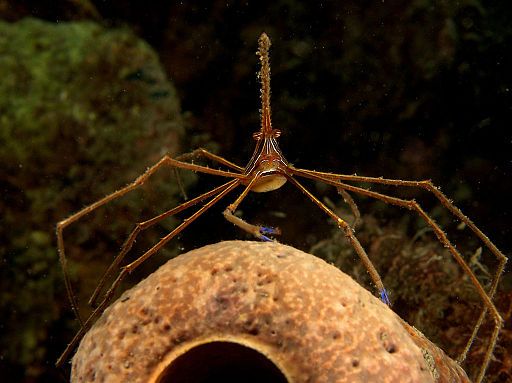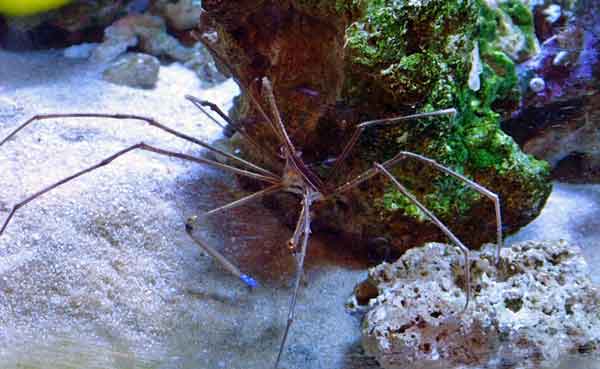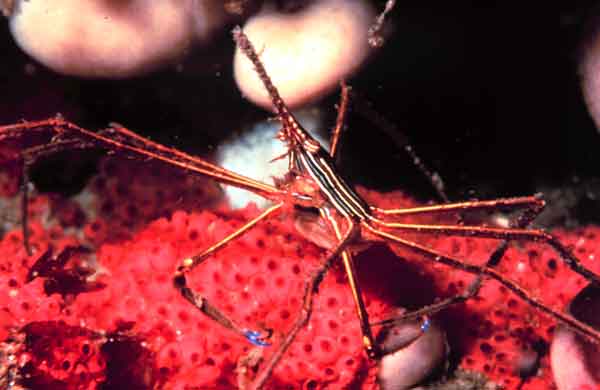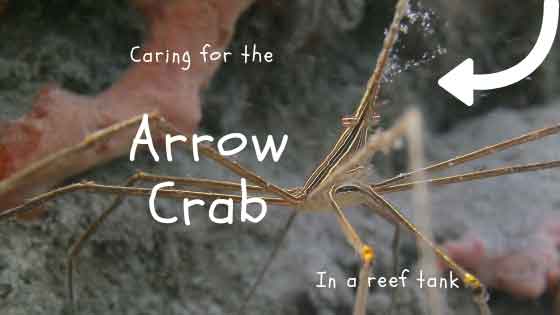[ad_1]
Fish are nice, corals are pretty. But if you want something with a real personality for your aquarium, I’d like to introduce you to a creature that’s sure to entertain. With its exotic look and graceful-yet-gawky movements, few aquarium specimens are as charming as the arrow crab.
Table of contents
This article is broken down into the following sections:
Introduction
The arrow crab is a fun and fascinating addition to a saltwater aquarium. It’s striking appearance, with long spindly legs and its long, pointed beak, or rostrum, make the arrow crab a beautiful counterpoint to other aquarium creatures. It has to be one of the most alien-looking invertebrates found on coral reefs, which is why it is such an awe-inspiring addition to any reef tank. Its fast movements add to its interest, and the species can even be helpful in controlling bristle worm infestations in an aquarium. But the arrow crab won’t be a perfect fit in every saltwater aquarium- its predatory and territorial nature can become problematic in some situations.
Scientific name and other names
The arrow crab, scientific name Stenorhynchus seticornis, also known as the Yellowline arrow crab, or the Arrowhead crab, is aptly named for its body shape, as you can see in the image below.
Description of the Arrowhead crab
A long, slender body and eight enormously long legs (up to three times its body length) are its most obvious characteristics. The body is cream to yellow-colored, with black, iridescent blue, and white stripes. From its appearance, it’s easy to see how it earned its name.
Along with several other species, it is also sometimes called a spider crab, which is fitting since it might easily be confused with some of its distant arachnid cousins. One of its most surprising features is its rostrum- the long slender spike that protrudes like a unicorn’s horn from the head. This long “snout”, flanked with buggy eyes gives the Arrowhead crab an unforgettable and almost comic face.
The natural habitat of the Arrowhead crab
Stenorhynchus seticornis are native to coral reefs throughout the Atlantic Ocean’s tropical and subtropical coasts, from the southern United States to South America, but especially in the Caribbean. They thrive in coral waters 10-30ft deep, but some have been found living much deeper. Arrowhead crabs are scavengers and will eat virtually any piece of dead material they may find, but they can also be predatory. The Arrowhead crab’s natural quarry is small reef-dwelling invertebrates, especially small duster worms.
Arrowhead crabs are opportunistic predators, and will also eat small crustaceans and slow fish as well, or pick at coral polyps. Arrow crabs are often found living among the tentacles of anemones or hiding out in small crevices and caves.
S. seticornis begin life hatching from an egg. After fertilization via a sperm packet transferred to the mother by a male, the eggs are carried attached to the mother’s body until they hatch into larvae. The larvae feed on plankton at the water’s surface, growing larger and larger, before finally undergoing metamorphoses into an adult form. Adults can live a year or more in captivity, and continue to grow.
Yellowline Arrow crab care
If you are considering adding the Yellowline Arrow crab to your saltwater aquarium, there are several considerations you will need to think about to make sure it will acclimate well to life in your personal slice of the reef. Although easy to care for, arrowhead crabs are predators and may become a killer of your other (small) prized fish, crustaceans, or coral if it gets too hungry.
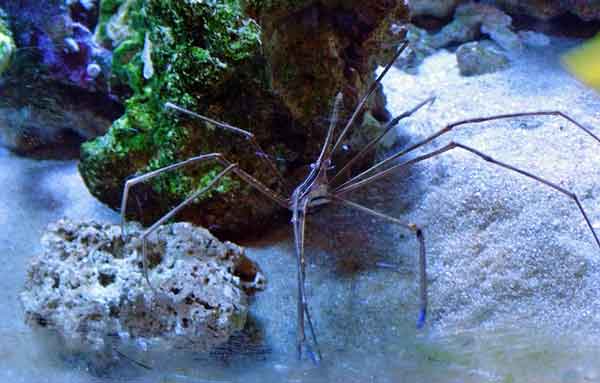
Looking for bristle worms in my reef tank–sorry about the dirty glass
Be sure your aquarium has lots of rockwork with suitable crevices and holes for the crab to hide in. Stenorhynchus seticornis will love crawling about the aquarium at night over rocks, corals, and the bottom of the tank. It will tend to hide under fan corals and any other type of shade or overhang during the day. In short, an arrow crab will do best and look best in an aquarium with a three-dimensional look and plenty of cover.
Think tunnels, ridges, and ledges for the arthropod to explore, hunt, and hide in.
Ideal water parameters
Arrow crab diet and feeding
Arrow crabs are both scavengers and predators. They can be great in an aquarium for preying on stinging bristle worms and scavenging for the remains of unfinished food. But the arrow crab has a dangerous side too- there is a possibility an arrow crab will attack small, slow fish, small crustaceans, or pick at living corals. This behavior can often be controlled by keeping arrow crabs well-fed, but anecdotal reports indicate that some individuals may be more naturally aggressive than others.
Arrowhead crabs are considered reef safe, but there is always some risk to corals and other creatures in an aquarium with almost any crab species. Keep an eye out for unwanted hunting.
Watch this video of them eating bristle worms:
Stenorhynchus seticornis size
Arrowhead crabs can grow as large as six inches, so they are ideally suited for medium or large tanks.
In a large tank, Stenorhynchus seticornis will have plenty of room to roam around its territory, and an aggressive action toward a coral or small fish from time to time will be less likely to be noticeable.
A smaller tank may make the aggressive behavior more likely–and therefore cause more problems.
Aggressiveness and territoriality
Arrowhead crabs are territorial and will not tolerate other members of the same species. In addition, some larger, more aggressive fish such as puffers may prey on the arrow crab.
In their natural habitat, the coral reef, Arrowhead crabs are not only predators but are also food for all manner of larger creatures. To hunt their invertebrate prey and scavenge in safety, arrow crabs do so under cover of darkness. They are nocturnal, so you aren’t likely to see them traipsing around the aquarium by day. If they choose a hiding spot that’s somewhat visible, they can still be observed during the day, and their beautiful slender forms can add a nice texture or peek-a-boo element to the aquascape.
During the night, the Arrowhead crab will be seen patrolling the tank, looking for morsels of meaty remains or hunting bristle worms. An Arrowhead crab is quite easy to care for, so long as it is matched with an environment, other species, and habits of care that are suitable.
Compatibility
This is an aggressive crab species, that is best kept singly. Don’t mix with other crabs or shrimp, and please don’t try to keep the Arrowhead crab with popular saltwater fish species that eat crabs and shrimp, like the Dog-faced pufferfish, Picasso triggerfish, or Hawkfish. Caution should also be provided that, like most other crab species, this is an opportunistic predator–which means that the individual you add to your tank might also be an occasional predator of any small, unsuspecting fish they can ambush (Calfo and Fenner 2003).
Captive breeding & reproduction
Due to their territorial nature, Arrowhead crabs have been considered, so far, to be very difficult or even impossible to breed in a home aquarium. Luckily, their charm has made it readily available from well-stocked pet stores as well as online.
Molting: Is my crab dead?
Like all crustaceans, Stenorhynchus seticornis will shed their hard exoskeleton in order to grow, periodically. This process is called molting. It can be scary, for you (because it may look like your crab has died), but is perfectly normal. The empty shell it leaves behind is a used exoskeleton, not a dead arthropod. The shell should be left in the aquarium so that the Arrowhead crab can eat it, to use the nutrients to build its new exoskeleton. The crabs also pull calcium from the water to help build their exoskeletons, so DKh levels are especially important, as they are for all shell-building creatures.
Conclusion
The Yellowline Arrow crab is a beautiful animal, with a striking shape and flamboyant striping.
Just watching them maneuver on its stilt-like legs in the aquarium is entertaining. Watching it hunt around the tank, and manipulate its prey or food with its outrageously proportioned claws is even more interesting. This is a truly alien-looking creature, sure to wow you and any visitors to your undersea world. With the right tankmates and good care, the Yellowline Arrow crab can be an excellent addition to your collection.
What are your thoughts about keeping the arrow crab? Please leave a comment below.
Diving deeper
Want to learn more about other interesting invertebrates? If you loved the Yellowline Arrow crab, you’ll also love reading about the harlequin shrimp care guide.
Or, to keep learning more, check out this video to learn all about the Arrowhead crab
References
Anthony Calfo and Robert Fenner (2003) Reef Invertebrates: An Essential Guide to Selection, Care and Compatibility, 2nd edn., Monroeville, PA: Reading Trees and Wet Web Media.
Julian Sprung (2001) Invertebrates: A Quick Reference Guide, 1st edn., Miami, FL: Ricordea Publishing.
[ad_2]
Source link

